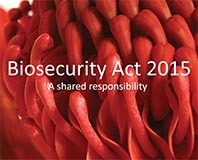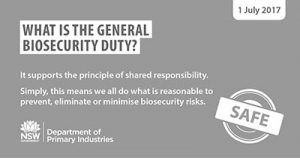Read the latest information on
Foot-and-mouth disease
 To coincide with the Biosecurity Act 2015 being enacted on 1 July 2017, the NSW Department of Primary Industries has released a series of fact sheets in relation to the new legislation to help you to understand your duty as a producer.
To coincide with the Biosecurity Act 2015 being enacted on 1 July 2017, the NSW Department of Primary Industries has released a series of fact sheets in relation to the new legislation to help you to understand your duty as a producer.
There’s a list of 29 different fact sheets, covering topics from abandoned and neglected horticultural enterprises, to biosecurity zones, straying stock and weeds.
The fact sheets provide an overview of key elements and principles of the Biosecurity Act, and summarise management tools and arrangements for a range of biosecurity risks.
One thing that a lot of farmers in Australia spend a lot of time doing is treating weeds, and with the introduction of new legislation, NSW farmers now have a duty to control weeds.
 So that everyone can play their part, NSW Department of Primary Industries has released 11 regional strategic weed management plans to safeguard the state against the threat of weeds.
So that everyone can play their part, NSW Department of Primary Industries has released 11 regional strategic weed management plans to safeguard the state against the threat of weeds.
In general, if you deal with or carry plant matter – including plants, parts of plants and seeds – as part of a commercial, professional, volunteer or recreational activity or lifestyle, it’s considered that you would know, or ought to know, the risks.
There are 11 regional strategic weed management plans that:
A full list of plans is available from the Local Land Services website. To download and read your local plan click here.